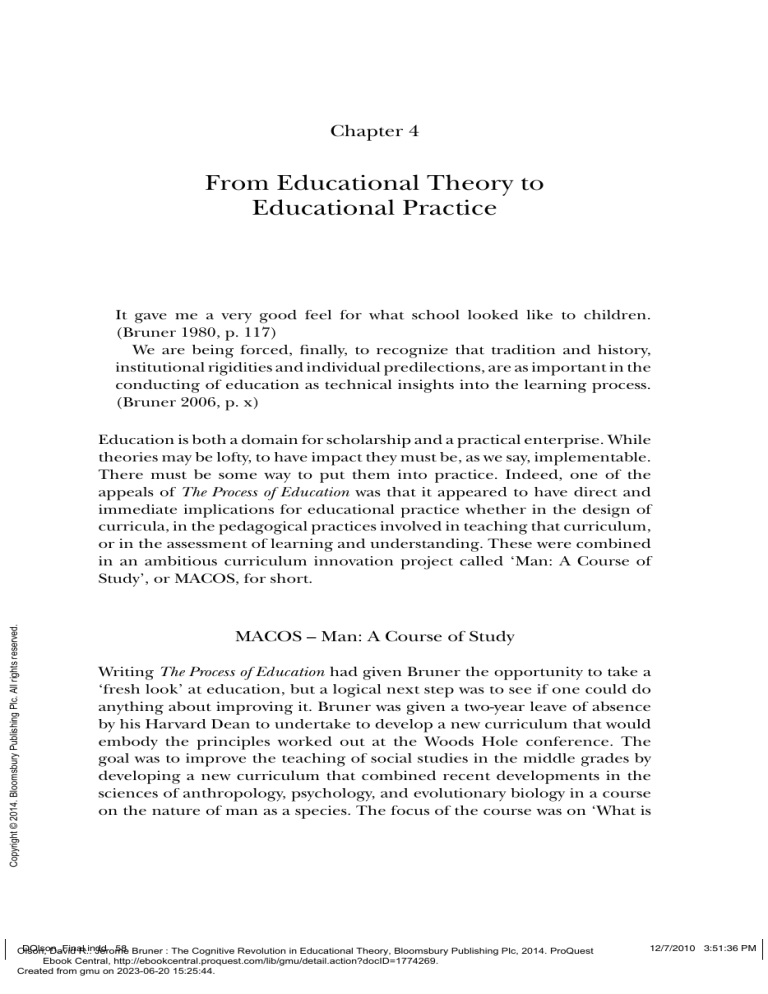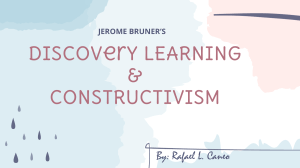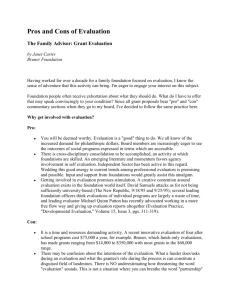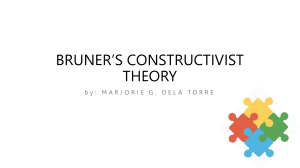
Chapter 4 From Educational Theory to Educational Practice It gave me a very good feel for what school looked like to children. (Bruner 1980, p. 117) We are being forced, finally, to recognize that tradition and history, institutional rigidities and individual predilections, are as important in the conducting of education as technical insights into the learning process. (Bruner 2006, p. x) Copyright © 2014. Bloomsbury Publishing Plc. All rights reserved. Education is both a domain for scholarship and a practical enterprise. While theories may be lofty, to have impact they must be, as we say, implementable. There must be some way to put them into practice. Indeed, one of the appeals of The Process of Education was that it appeared to have direct and immediate implications for educational practice whether in the design of curricula, in the pedagogical practices involved in teaching that curriculum, or in the assessment of learning and understanding. These were combined in an ambitious curriculum innovation project called ‘Man: A Course of Study’, or MACOS, for short. MACOS – Man: A Course of Study Writing The Process of Education had given Bruner the opportunity to take a ‘fresh look’ at education, but a logical next step was to see if one could do anything about improving it. Bruner was given a two-year leave of absence by his Harvard Dean to undertake to develop a new curriculum that would embody the principles worked out at the Woods Hole conference. The goal was to improve the teaching of social studies in the middle grades by developing a new curriculum that combined recent developments in the sciences of anthropology, psychology, and evolutionary biology in a course on the nature of man as a species. The focus of the course was on ‘What is DOlson_Final.indd 58 Bruner : The Cognitive Revolution in Educational Theory, Bloomsbury Publishing Plc, 2014. ProQuest Olson, David R.. Jerome Ebook Central, http://ebookcentral.proquest.com/lib/gmu/detail.action?docID=1774269. Created from gmu on 2023-06-20 15:25:44. 12/7/2010 3:51:36 PM Copyright © 2014. Bloomsbury Publishing Plc. All rights reserved. From Educational Theory to Educational Practice 43 uniquely human about human beings?’ and ‘How did human beings get that way?’ ‘What could be done to make them more so?’ The goals of the unit of study were, first and foremost, to give pupils respect for and confidence in the powers of their own minds, the power to think about the human condition, to develop a set of models for understanding the social world, and to show that human evolution is an ongoing process (see Bruner 1996c, Chapter 4). Notice how the goal of getting the students to think was seen as more important than, and indeed, the key to the learning of content knowledge whether in anthropology, psychology, or biology. Peter Dow, a participant in the project and later its principal administrator, drawing on the vast archives from the project, has written a brilliant and detailed history of the project from its inception, through its development to its impact. The aim, as Dow (1991) put it, ‘was to construct a new model for social studies education that would change the existing pattern’ (p. 73) and ‘close the gap between intellectual discovery as it occurs on the cutting edge of scholarship, and learning as it occurs in a growing young mind’ (p. 273). In collaboration with experts, teachers, teacher trainers, and graduate students Bruner developed, extensively piloted with groups of children, and revised course materials, films and texts dealing with the life cycle of different non-human animal species, including baboons, as well as two ‘traditional’ human societies, Netsilik Eskimos and Kalahari Bushmen. The goal was to explore what was distinctive about humans as a species and to explore the relationship between environment, culture, and behavior. Topics such as why Eskimos ate raw meat were particularly appealing to children and drew both emotion and debate. Topics that did not work were dropped from the program. One such unit of instruction, the ‘containers unit’ that ‘challenged children to create from simple materials durable carrying devices that would allow safe transport to and from school of two raw eggs and a cup of water, failed to produce a measurable impact on children’s thinking about technology, even though it was hugely popular with students’, quipped Petter Dow (1991, p. 114). Language, of course, was one of the things that make humans unique and so was part of the curriculum. However, teaching children what made language special proved to be unexpectedly difficult, nigh unto impossible. This was 1966, shortly after Chomsky had defended the claim that what was unique about humans was their innate grammatical competence. The grammar, namely rules for turning separate words into sentences, was to be distinguished from the semantics, the meaning that sentences expressed. Thus ‘Colorless green ideas sleep furiously’ was a grammatical sentence even if it did not mean anything. Children simply could not grasp that that was a sentence while they were quite willing to accept ungrammatical strings such as ‘The man hat has’ as a sentence because they knew what it meant. DOlson_Final.indd 59 Bruner : The Cognitive Revolution in Educational Theory, Bloomsbury Publishing Plc, 2014. ProQuest Olson, David R.. Jerome Ebook Central, http://ebookcentral.proquest.com/lib/gmu/detail.action?docID=1774269. Created from gmu on 2023-06-20 15:25:44. 12/7/2010 3:51:36 PM 44 Critical Exposition of Bruner’s Work Grammar as a metalinguistic concept was too difficult and so had to be approached in another way.6 In this other way a series of simple sentences was written on the board and the children were encouraged to read one word from each column to make up new sentences. Copyright © 2014. Bloomsbury Publishing Plc. All rights reserved. The A The My man boy dog father ate stole chased skidded his a my the lunch bike cat car Some sentences such as ‘My father ate a car’ were undoubtedly odd but by this means children were able to grasp the notion of the grammar as composed of parts such as nouns, verbs, and modifiers, and to think about what a language was (Bruner 1971, pp. 73–4). Yet, despite the heroic efforts of teachers, these ten-year-olds were reluctant to grant that the sounds made by other species were any less ‘linguistic’ than those made by humans. Nor did they easily shed their anthropomorphism, identifying easily with the young of all other species including salmon, herring gulls, and baboons and expressing a willingness to project human feelings on to them. The research was indeed exemplary. It combined the best of current knowledge and advances in the human sciences, it had clear goals and appropriate means of assessment, it was tried out with the types of students that it was designed to teach, and teachers and educators were taught how to use the program and how to introduce it into their schools. It involved a gargantuan effort. Bruner devoted his two-year leave of absence from Harvard to the development of the program, assembled a staff of over 60 people to try out the new curriculum over two summers, conducted systematic appraisals of the program and, after several attempts delivered this into a publisher’s hand. In its final form it included nine teacher’s guides, 30 children’s booklets, 16 films, four records, five filmstrips, three games, 54 artifact cards, two large maps, three large charts, 11 posters and a ‘take-apart seal’ (Dow 1991, p. 134). Dissemination of the program was almost as complex as developing it. Lectures and workshops, demonstrations and word-of-mouth contacts spread the program, trained the teachers, and developed materials even before publishers came on board. The program was enthusiastically received by reform-minded educators and by 1970 there were 918 teachers using the program with more than 22,000 pupils. The American Educational Research Association together with the American Educational Publishers Institute presented Bruner with an award for ‘one of the most important efforts of our time to relate research findings and theory in educational psychology to the development of new and better instructional material’ and praised it as ‘enormously suggestive of what we could and should be doing to equip the instructional process adequately’ (Dow 1991, p. 135). DOlson_Final.indd 60 Bruner : The Cognitive Revolution in Educational Theory, Bloomsbury Publishing Plc, 2014. ProQuest Olson, David R.. Jerome Ebook Central, http://ebookcentral.proquest.com/lib/gmu/detail.action?docID=1774269. Created from gmu on 2023-06-20 15:25:44. 12/7/2010 3:51:36 PM From Educational Theory to Educational Practice 45 Yet, by and large, it failed not only to survive but also to have a lasting impact on schooling. Schooling has tended to revert to the old standard methods of teaching and testing. Why? There are many answers that I shall examine when we come to discuss the reception of Bruner’s work. But in a word, although progressively minded educators enthusiastically received and adopted the new curriculum, it was treated skeptically by a conservative, indeed, a reactionary public and it became a battleground on which governing officials and policy makers fought their internecine battles. Copyright © 2014. Bloomsbury Publishing Plc. All rights reserved. Scaffolding: Explorations in Pedagogy If one can describe a trajectory in Bruner’s thinking from his efforts in curriculum development to his later work, it was his increasing attention to what actually happened in the instructional processes. He set out to describe ‘the close-textured pattern of reciprocity about the intentional states of one’s partners’ (Bruner 1996, p. 182). He would later describe this reciprocity in terms of intersubjectivity. But at the end of his curriculum efforts, he looked for the analysis in terms of the actual pedagogical moves available to the teacher as instructor. It was a kind of teaching by modeling, showing and telling, that he called scaffolding. At the time that Bruner was writing, the perspective on pedagogy, like the perspective on curriculum, was still essentially teacher-centered and teacher-controlled. It was a deliberate attempt to bring the behavior of the learner into compliance with the ideas and goals of the teacher. Of course, what else is instruction but the attempt to shape a learner’s habits, attitudes and beliefs? But, unlike some of the proposals Bruner examined later, he saw instruction as essentially the attempt to bring the learner up to the adult’s standard by providing a framework for the child’s learning. Scaffolding was the application of an engineering model to pedagogical practice. The teacher constructed a scaffold that could be used to support the efforts of the learner to construct his or her own understandings. Once complete, the scaffold could be removed and the learner’s own mental structures would sustain understanding and enquiry. With David Wood of Nottingham University, Bruner studied the process involved when an adult tutored three- to five-year-old children on how to assemble a complex pyramid puzzle. Rather than teach in the conventional sense of telling and explaining the adult tutor would ‘scaffold’ the efforts by carrying out the parts of the task that the child could not quite successfully manage for itself. As the learner mastered parts of the task, the adult would give control of those aspects back to the learner. Ultimately, the child could manage the entire process by him or herself. DOlson_Final.indd 61 Bruner : The Cognitive Revolution in Educational Theory, Bloomsbury Publishing Plc, 2014. ProQuest Olson, David R.. Jerome Ebook Central, http://ebookcentral.proquest.com/lib/gmu/detail.action?docID=1774269. Created from gmu on 2023-06-20 15:25:44. 12/7/2010 3:51:37 PM 46 Critical Exposition of Bruner’s Work These interactive structures Bruner re-described as ‘formats’ and found them not only in situations with a specific pedagogical intent, as in the scaffolding context for teaching, but also in the routines that parents engage in with their children, routines important for language learning and cultural learning more generally. A format is a cultural routine in a conventionalized setting in which parent and child take on interactive roles to complete a task or play a game. One such format he studied in more detail was that of ‘book reading’ in which the mother pointed out and named pictures in a book, a practice progressively taken over by the year-old child. Here is Bruner’s description: Copyright © 2014. Bloomsbury Publishing Plc. All rights reserved. What a strikingly stable routine it was. Each step of the way, the mother incorporated whatever competencies the child had already developed – to be clued by pointing, to appreciate that sounds ‘stood for’ things and events, etc. The mother remained the constant throughout. Thereby she was his scaffold – calling his attention, making a query, providing an answering label if he lacked one, and confirming his offer of one, whatever it might be. As he gained competence, she would raise her criterion. Almost any vocalization the child might offer at the start would be accepted. But each time the child came closer to the standard form, she would hold out for it. What was changing was, of course, what the mother expected in response – and that, of course, was ‘fine-tuned’ by her ‘theory’ of the child’s capacities. When he switched from babbling to offering shorter vocalization as ‘labels’ (still quite nonstandard), she would no longer accept babbles but would insist on the shorter ‘names’. Then finally, sure that her son knew the standard label, she would shift to delivering her ‘What’s that?’ with a falling intonation on the second word and a special smile to distinguish a rhetorical from a nonrhetorical question. And so it went. (1983a, pp. 171–2; see also Bruner 1983b). Scaffolding learning, as Bruner acknowledged, was what apprenticeships traded on. A novice would be given small tasks at the margins of a complex task and, as mastery increased, be given greater and greater responsibility for more and more complex tasks. Apprenticeships had long been studied in traditional craft societies but the applicability of these methods to education in a modern industrial society had been largely overlooked. More recent studies by Greenfield and Lave (1982), Lave and Wenger (1991) and Rogoff (1990; Rogoff, Mutusov, and White 1996) have not only shown the importance of these methods to contemporary schooling but also that they are already inescapably common if unacknowledged. Students in classrooms tend to be given responsibility for tasks for which they have a reasonable chance of success, with requirements increasing as they demonstrate DOlson_Final.indd 62 Bruner : The Cognitive Revolution in Educational Theory, Bloomsbury Publishing Plc, 2014. ProQuest Olson, David R.. Jerome Ebook Central, http://ebookcentral.proquest.com/lib/gmu/detail.action?docID=1774269. Created from gmu on 2023-06-20 15:25:44. 12/7/2010 3:51:37 PM From Educational Theory to Educational Practice 47 increased competence. What is often neglected, however, is the fact that students often fail to grasp ‘the larger purpose’ behind these more local tasks. Studying punctuation, for example, may have limited returns unless the learner sees how punctuation can actually increase comprehensibility. It is worth noting that Bruner’s pedagogical explorations tended to involve one-on-one teaching episodes. In such a context it is enormously easier to keep track of what the learner is thinking. In whole-class teaching, on the other hand, such close monitoring is virtually impossible and teachers have to monitor for general signs of incomprehension, say, watching the modal student, and adjusting teaching accordingly. Just how teachers do this has not been studied in detail and as Bruner acknowledged, ‘The chemistry of classroom still eludes me – whether it produces leaden gloom or total and concentrated involvement’ (1980, pp. 129–30). Copyright © 2014. Bloomsbury Publishing Plc. All rights reserved. Head Start As mentioned, as an insider to President Johnson’s War on Poverty in the 1960s Bruner was drawn into Project Head Start, a program that was designed to overcome the difficulties faced by poor and underprivileged children on entering school. Although Bruner has been an advocate of and spokesman for Head Start’s early educational intervention program, and although he served on a White House committee, he did not play an active role in that program. The idea was fueled not only by obvious social need but also by psychological research that had shown the debilitating effects of sensory deprivation in animals. Animals reared in impoverished environments were found to be severely disabled on later learning and problem-solving tasks. At about the same time, studies of human infants showed that they were alert, attentive to the social world, and more active than reactive than had been suspected, and in addition, were rapid learners. So somewhere between these intelligent and engaged infants and the onset of schooling something seemed to have numbed the intellect. The problem was seen as one of the impoverished conditions experienced by children of the poor. What was called ‘cultural deprivation’ was seen as limiting their continuing mental growth. Head Start was created to fill that gap. Head Start was premised on the notion that if pre-school children could be given a richer environment they would be more intellectually developed and more prepared for formal schooling. Faith in the effectiveness of these early interventions faded in the 1970s when the research began to show that the advantages gained tended to disappear within a few years. Bruner disagreed, arguing that the disappointing results that were reported did not give a fair account of the effectiveness of the programs because the DOlson_Final.indd 63 Bruner : The Cognitive Revolution in Educational Theory, Bloomsbury Publishing Plc, 2014. ProQuest Olson, David R.. Jerome Ebook Central, http://ebookcentral.proquest.com/lib/gmu/detail.action?docID=1774269. Created from gmu on 2023-06-20 15:25:44. 12/7/2010 3:51:37 PM 48 Critical Exposition of Bruner’s Work criteria used to evaluate them were limited to simple skills. He had urged rather that those criteria should have included the growth of an interest in and thoughtfulness about the world and a willingness to share those experiences with others. Nonetheless the disappointing data, coupled with the costs of the program (which in fact were trivial in comparison to those required by the Vietnam War) led to severe reductions in the program although it did not disappear completely. Although Head Start was not ‘a magic elixir’ (Bruner 1996, p. 75), recent re-evaluations have shown that if the interventions are continued over a longer period they do indeed have cumulative and long-lasting effects (Schweinhart and Weikart 1980; Barnett 1993). Disadvantaged children can indeed be helped. Bruner continues to be a staunch advocate of pre-school education. Head Start, he said, ‘created a new consciousness that, by intervening in the developmental scene early enough, you could change the life of children later’ (1996, p. 74). Indeed, currently, pre-school education is high on the agenda of most developed nations. Copyright © 2014. Bloomsbury Publishing Plc. All rights reserved. Reggio Emilia Over the past two decades Bruner has been advisor and consultant to a unique education program in Reggio Emilia, an autonomous region of Italy, that combines a strong socialist stance with a deep commitment to educational equality. The program is very much built on the constructivist principles described by Bruner in which children take control of their own learning and in which the teacher’s role is primarily helping the children achieve their own goals and succeed with their own projects. The primary observations Bruner made in this context were that no child was incapable of actively participating in the enterprise, no child failed to learn both the skills and knowledge valued by the school, and furthermore a true learning community was possible. For his help with this enterprise Bruner was made an honorary citizen of the community. Lillard (2005) has recently appraised the Montessori early education program and found it to possess many of the virtues that Bruner found laudatory in Reggio Emilia. Programs which put the mental activities of the learners at the forefront of pedagogical efforts are not confined to foreign shores. Bruner observed and commented on the encouraging effects of the reciprocal teaching and collaborative learning practices implemented by Ann Brown, Joe Campione, and Anne-Marie Palincsar in a disadvantaged area of Oakland, California (Palincsar 1984; Brown and Campione 1994). What was distinctive was not only that the children achieved unpredictably well but also that they had succeeded in creating a collaborative school culture, a community of learners DOlson_Final.indd 64 Bruner : The Cognitive Revolution in Educational Theory, Bloomsbury Publishing Plc, 2014. ProQuest Olson, David R.. Jerome Ebook Central, http://ebookcentral.proquest.com/lib/gmu/detail.action?docID=1774269. Created from gmu on 2023-06-20 15:25:44. 12/7/2010 3:51:37 PM Copyright © 2014. Bloomsbury Publishing Plc. All rights reserved. From Educational Theory to Educational Practice 49 (Bruner 1996, pp. 76–9; see also Rogoff, Matusov, and White 1996). Children worked on shared projects, they put their proposals up for common discussion, they assigned various roles – researcher, chairman, reporter – to different children at different times, they shared their discoveries, summarized, questioned, and clarified their views and thereby jointly contributed to a common project. The teacher played a critical role in the process but one of helping the community to get the job done, thereby keeping the agency and responsibility in the hands of the learners rather than in the hands of the teacher. Bruner attributed the success of the practice to an established principle: ‘We have known for years that if you treat people, young kids included, as responsible, contributing parties to the group, as having a job to do, they will grow into it.’ The school culture that results from such practices he described as ‘creating communities of learners . . . Learning is best when it is participatory, proactive, communal, collaborative, and given over to constructing meanings rather than receiving them’ (1996, p. 84). These were the very practices he had identified in Reggio Emilia. Bruner’s contributions to pedagogy, then, were both theoretical and practical. He showed that the new understanding of mind as hypothesis testing and model building could provide an alternative approach to both curriculum development and pedagogy. In the former, he showed that a curriculum with a defined content with high intellectual goals could be developed and taught using what he called the ‘hypothetical mode’, namely, getting children to invent hypotheses, discuss them, weigh them against alternative hypotheses and against further evidence. Furthermore, he showed that such practices could be implemented in an ordinary classroom. In regard to the latter, he demonstrated the complementary roles between teacher and learner could be seen as a form of scaffolding in which the actions of the teacher served primarily to allow the learner to progressively take over the component skills as competence developed. Thus the role of the teacher moved aside somewhat to allow greater freedom for the child to increasingly take responsibility for his or her actions. And as an advocate, he provided both the encouragement and the rationale for education in a modern society and for methods that acknowledge the role of the learner in constructing his or her own knowledge and understanding. (I interviewed Bruner about his concept of teaching the hypothetical and a transcript of the discussion is presented in Appendix C. Our discussion of Reggio Emilia is found in Appendix E.) DOlson_Final.indd 65 Bruner : The Cognitive Revolution in Educational Theory, Bloomsbury Publishing Plc, 2014. ProQuest Olson, David R.. Jerome Ebook Central, http://ebookcentral.proquest.com/lib/gmu/detail.action?docID=1774269. Created from gmu on 2023-06-20 15:25:44. 12/7/2010 3:51:37 PM






